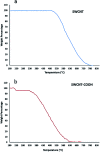A high precision length-based carbon nanotube ladder
- PMID: 35558502
- PMCID: PMC9088388
- DOI: 10.1039/c8ra05482g
A high precision length-based carbon nanotube ladder
Abstract
Today, carbon nanotubes manufacturers as well as users such as molecular electronics, nanomedicine, nano-biotechnology and similar industries are facing a major challenge: lack of length uniformity of carbon nanotubes in mass production. An effective solution to this major issue is the use of a length-based ladder. We are, for the first time, presenting such a valuable tool to determine the length purity. Our length-based carbon nanotubes ladder, containing a series of carbon nanotubes markers with different lengths, is made based on three combined techniques - bio-conjugation, sodium dodecyl sulfate polyacrylamide gel electrophoresis (SDS-PAGE), and silver staining. Creating an indicator using conjugation of a biomolecule with carbon nanotubes to make a carbon nanotubes ladder is a novel idea and a significant step forward for length-based carbon nanotubes separation. The very sensitive silver staining technique allows a precise visualization and quantification of the gel. This ladder with a pending patent by Northeastern University is an effective quality control tool when bulk quantities of nanotubes with a desirable length are manufactured.
This journal is © The Royal Society of Chemistry.
Conflict of interest statement
There are no conflicts to declare.
Figures








Similar articles
-
A high precision method for length-based separation of carbon nanotubes using bio-conjugation, SDS-PAGE and silver staining.PLoS One. 2018 Jun 25;13(6):e0197972. doi: 10.1371/journal.pone.0197972. eCollection 2018. PLoS One. 2018. PMID: 29939999 Free PMC article.
-
Carbon nanotube-modified sodium dodecyl sulfate-polyacrylamide gel electrophoresis for molecular weight determination of proteins.Anal Biochem. 2011 Feb 15;409(2):230-5. doi: 10.1016/j.ab.2010.10.021. Epub 2010 Nov 2. Anal Biochem. 2011. PMID: 20971050
-
Mixed anionic detergent/aliphatic alcohol-polyacrylamide gel electrophoresis alters the separation of proteins relative to conventional sodium dodecyl sulfate-polyacrylamide gel electrophoresis.Anal Biochem. 1988 Oct;174(1):337-48. doi: 10.1016/0003-2697(88)90555-6. Anal Biochem. 1988. PMID: 3218745
-
Employing Raman spectroscopy to qualitatively evaluate the purity of carbon single-wall nanotube materials.J Nanosci Nanotechnol. 2004 Sep;4(7):691-703. doi: 10.1166/jnn.2004.116. J Nanosci Nanotechnol. 2004. PMID: 15570946 Review.
-
Carbon nanotube-based functional materials for optical limiting.J Nanosci Nanotechnol. 2007 Apr-May;7(4-5):1268-83. doi: 10.1166/jnn.2007.308. J Nanosci Nanotechnol. 2007. PMID: 17450890 Review.
References
-
- Rakov E. G. Russ. Chem. Rev. 2000;69:35–52. doi: 10.1070/RC2000v069n01ABEH000531. - DOI
-
- Hennrich F. Lebedkin S. Malik S. Tracy J. Barczewski M. Rösner H. Kappes M. Phys. Chem. Chem. Phys. 2002;4:2273–2277. doi: 10.1039/B201570F. - DOI
-
- Mohsenian S. Fathi J. Shokri B. Appl. Phys. A: Mater. Sci. Process. 2018;124:546. doi: 10.1007/s00339-018-1983-9. - DOI
-
- Hermann S. Pahl B. Ecke R. Schulz S. E. Gessner T. Microelectron. Eng. 2010;87:438–442. doi: 10.1016/j.mee.2009.05.027. - DOI
LinkOut - more resources
Full Text Sources
Other Literature Sources

